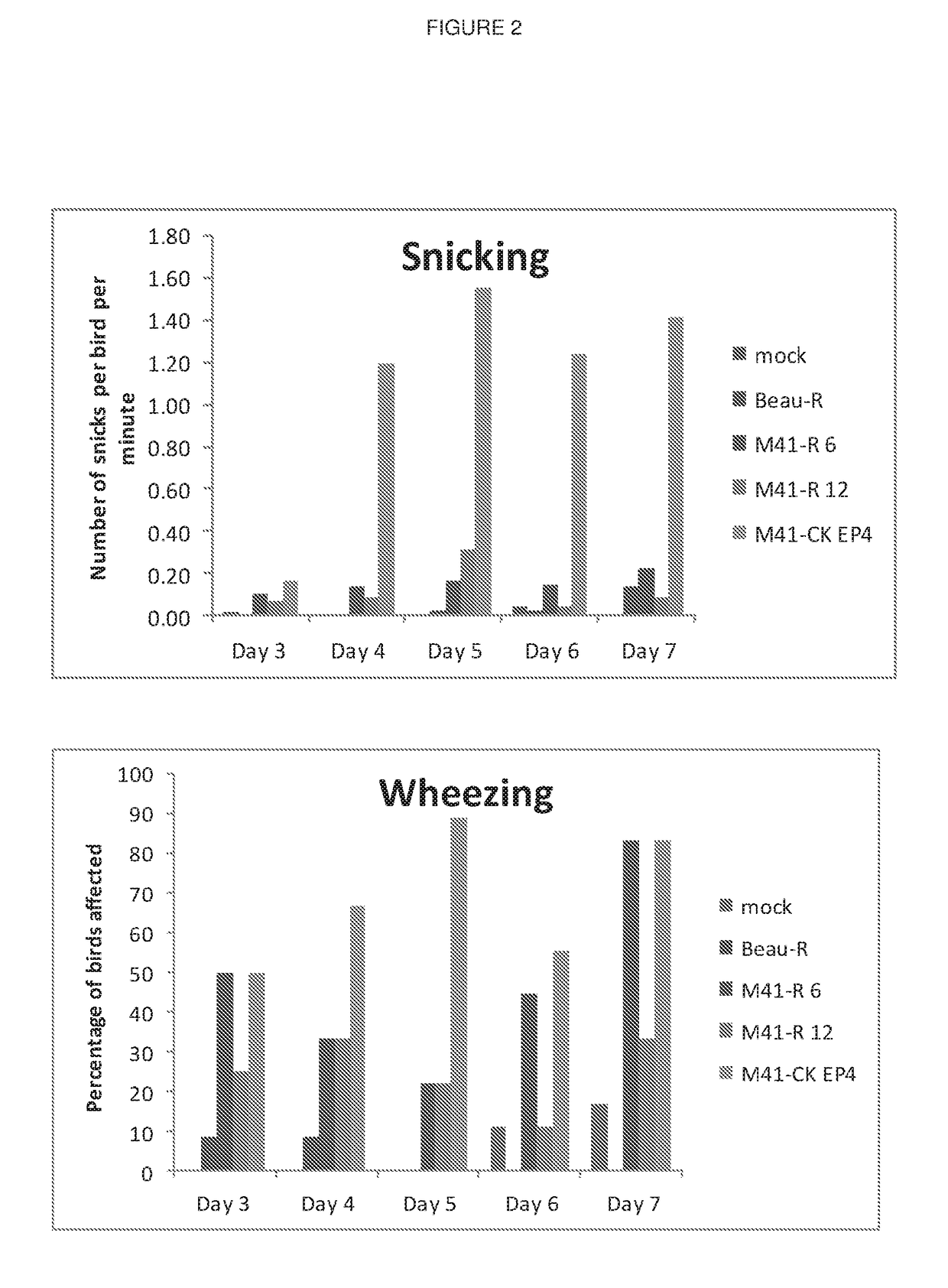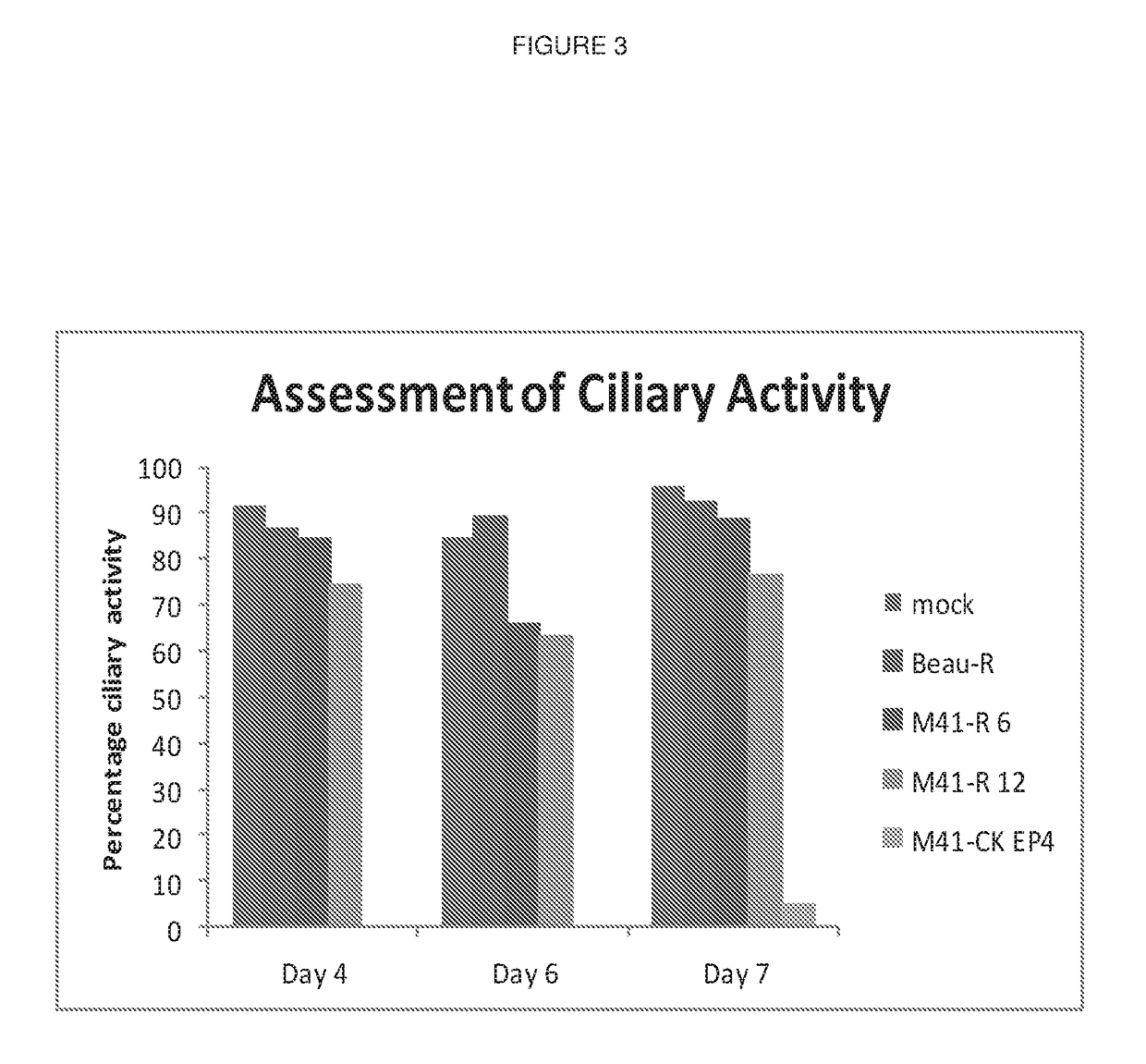Coronavirus
a coronavirus and anti-coronavirus technology, applied in the field of attenuated coronavirus, can solve the problems of reduced egg production and quality, and death of kidney diseases
- Summary
- Abstract
- Description
- Claims
- Application Information
AI Technical Summary
Benefits of technology
Problems solved by technology
Method used
Image
Examples
example 1
n of an IBV Reverse Genetics System Based on M41-CK
[0276]A M41-CK full-length cDNA was produced by replacement of the Beaudette cDNA in the Vaccinia virus reverse genetics system previously described in PCT / GB2010 / 001293 (herein incorporated by reference) with synthetic cDNA derived from the M41 consensus sequence.
[0277]The IBV cDNA within recombinant Vaccinia virus (rVV) rVV-BeauR-Rep-M41 structure described in Armesto, Cavanagh and Britton (2009). PLoS ONE 4(10): e7384. doi:10.1371 / journal.pone.0007384, which consisted of the replicase derived from IBV Beaudette strain and the structural and accessory genes and 3′ UTR from IBV M41-CK, was further modified by replacement of the Beaudette 5′ UTR-Nsp2-Nsp3 sequence with the corresponding sequence from IBV M41-CK. The resulting IBV cDNA consisted of 5′ UTR-Nsp2-Nsp3 from M41, Nsp4-Nsp16 from Beaudette and the structural and accessory genes and 3′ UTR from M41. This cDNA was further modified by the deletion of the Beaudette Nsp4-Nsp16 ...
example 2
ng the Pathogenicity of Rescued M41 Viruses
[0279]The viruses rescued in Example 1 were used to infect 8-day-old specific pathogen free (SPF) chicks by ocular and nasal inoculation to test them for pathogenicity, as observed by clinical signs on a daily basis 3-7 days post-infection and for ciliary activity days 4 and 6 post-infection. Loss of ciliary activity is a well-established method for determining the pathogenicity of IBV. The two M41-R viruses were found to be apathogenic when compared to M41-CK though they did show some clinical signs in comparison to uninfected control chicks (FIG. 2) and some but inconsistent loss in ciliary activity (FIG. 3).
[0280]Thus, the M41-R molecular clones of M41-CK were not pathogenic when compared to the parental virus M41-CK.
[0281]The inventors identified several nucleotide differences in the M41-R compared to the M41-CK sequences. The majority of these were synonymous mutations, as the nucleotide change did not affect the amino acid sequence of...
example 3
M41-R rIBVs
[0283]In order to determine whether the identified mutations were responsible for the loss of pathogenicity associated with M41-R, the Nsp10 mutation was repaired and the mutations in Nsp-14, -15 & -16 were repaired and shown to grow in a similar manner as M41-CK (FIG. 9). The inventors thus generated the rIBVs, M41R-nsp10rep and M41R-nsp14, 15, 16rep, using synthetic cDNAs containing the correct nucleotides utilising the inventor's previous described (TDS) system (see PCT / GB2010 / 001293).
[0284]The rIBVs were assessed for pathogenicity in chicks as described previously. Both rIBVs showed increased pathogenicity when compared to M41-R but not to the level observed with M41-CK (FIGS. 4 and 5). M41R-nsp14, 15, 16rep gave more clinical signs and more reduction in ciliary activity than M41R-nsp10rep, overall these results indicated that the changes associated with the four Nsps appear to affect pathogenicity.
[0285]To determine the roles of the Nsps in pathogenicity the full-len...
PUM
| Property | Measurement | Unit |
|---|---|---|
| weight | aaaaa | aaaaa |
| stability | aaaaa | aaaaa |
| genomic size | aaaaa | aaaaa |
Abstract
Description
Claims
Application Information
 Login to View More
Login to View More - R&D
- Intellectual Property
- Life Sciences
- Materials
- Tech Scout
- Unparalleled Data Quality
- Higher Quality Content
- 60% Fewer Hallucinations
Browse by: Latest US Patents, China's latest patents, Technical Efficacy Thesaurus, Application Domain, Technology Topic, Popular Technical Reports.
© 2025 PatSnap. All rights reserved.Legal|Privacy policy|Modern Slavery Act Transparency Statement|Sitemap|About US| Contact US: help@patsnap.com



